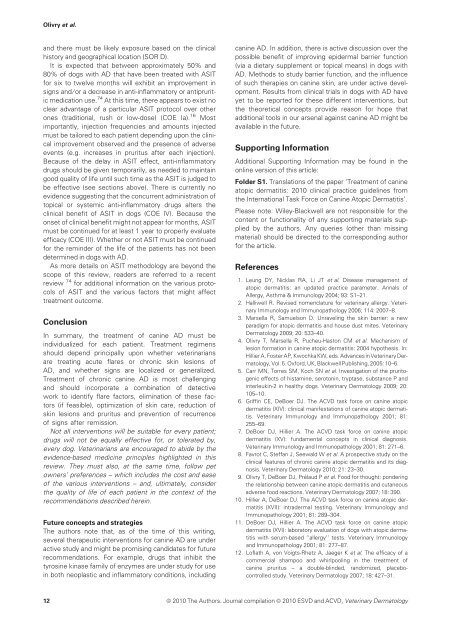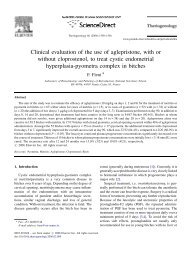Treatment of canine atopic dermatitis: 2010 clinical practice ...
Treatment of canine atopic dermatitis: 2010 clinical practice ...
Treatment of canine atopic dermatitis: 2010 clinical practice ...
You also want an ePaper? Increase the reach of your titles
YUMPU automatically turns print PDFs into web optimized ePapers that Google loves.
Olivry et al.<br />
and there must be likely exposure based on the <strong>clinical</strong><br />
history and geographical location (SOR D).<br />
It is expected that between approximately 50% and<br />
80% <strong>of</strong> dogs with AD that have been treated with ASIT<br />
for six to twelve months will exhibit an improvement in<br />
signs and ⁄ or a decrease in anti-inflammatory or antipruritic<br />
medication use. 74 At this time, there appears to exist no<br />
clear advantage <strong>of</strong> a particular ASIT protocol over other<br />
ones (traditional, rush or low-dose) (COE Ia). 16 Most<br />
importantly, injection frequencies and amounts injected<br />
must be tailored to each patient depending upon the <strong>clinical</strong><br />
improvement observed and the presence <strong>of</strong> adverse<br />
events (e.g. increases in pruritus after each injection).<br />
Because <strong>of</strong> the delay in ASIT effect, anti-inflammatory<br />
drugs should be given temporarily, as needed to maintain<br />
good quality <strong>of</strong> life until such time as the ASIT is judged to<br />
be effective (see sections above). There is currently no<br />
evidence suggesting that the concurrent administration <strong>of</strong><br />
topical or systemic anti-inflammatory drugs alters the<br />
<strong>clinical</strong> benefit <strong>of</strong> ASIT in dogs (COE IV). Because the<br />
onset <strong>of</strong> <strong>clinical</strong> benefit might not appear for months, ASIT<br />
must be continued for at least 1 year to properly evaluate<br />
efficacy (COE III). Whether or not ASIT must be continued<br />
for the reminder <strong>of</strong> the life <strong>of</strong> the patients has not been<br />
determined in dogs with AD.<br />
As more details on ASIT methodology are beyond the<br />
scope <strong>of</strong> this review, readers are referred to a recent<br />
review 74 for additional information on the various protocols<br />
<strong>of</strong> ASIT and the various factors that might affect<br />
treatment outcome.<br />
Conclusion<br />
In summary, the treatment <strong>of</strong> <strong>canine</strong> AD must be<br />
individualized for each patient. <strong>Treatment</strong> regimens<br />
should depend principally upon whether veterinarians<br />
are treating acute flares or chronic skin lesions <strong>of</strong><br />
AD, and whether signs are localized or generalized.<br />
<strong>Treatment</strong> <strong>of</strong> chronic <strong>canine</strong> AD is most challenging<br />
and should incorporate a combination <strong>of</strong> detective<br />
work to identify flare factors, elimination <strong>of</strong> these factors<br />
(if feasible), optimization <strong>of</strong> skin care, reduction <strong>of</strong><br />
skin lesions and pruritus and prevention <strong>of</strong> recurrence<br />
<strong>of</strong> signs after remission.<br />
Not all interventions will be suitable for every patient;<br />
drugs will not be equally effective for, or tolerated by,<br />
every dog. Veterinarians are encouraged to abide by the<br />
evidence-based medicine principles highlighted in this<br />
review. They must also, at the same time, follow pet<br />
owners’ preferences – which includes the cost and ease<br />
<strong>of</strong> the various interventions – and, ultimately, consider<br />
the quality <strong>of</strong> life <strong>of</strong> each patient in the context <strong>of</strong> the<br />
recommendations described herein.<br />
Future concepts and strategies<br />
The authors note that, as <strong>of</strong> the time <strong>of</strong> this writing,<br />
several therapeutic interventions for <strong>canine</strong> AD are under<br />
active study and might be promising candidates for future<br />
recommendations. For example, drugs that inhibit the<br />
tyrosine kinase family <strong>of</strong> enzymes are under study for use<br />
in both neoplastic and inflammatory conditions, including<br />
<strong>canine</strong> AD. In addition, there is active discussion over the<br />
possible benefit <strong>of</strong> improving epidermal barrier function<br />
(via a dietary supplement or topical means) in dogs with<br />
AD. Methods to study barrier function, and the influence<br />
<strong>of</strong> such therapies on <strong>canine</strong> skin, are under active development.<br />
Results from <strong>clinical</strong> trials in dogs with AD have<br />
yet to be reported for these different interventions, but<br />
the theoretical concepts provide reason for hope that<br />
additional tools in our arsenal against <strong>canine</strong> AD might be<br />
available in the future.<br />
Supporting Information<br />
Additional Supporting Information may be found in the<br />
online version <strong>of</strong> this article:<br />
Folder S1. Translations <strong>of</strong> the paper ‘<strong>Treatment</strong> <strong>of</strong> <strong>canine</strong><br />
<strong>atopic</strong> <strong>dermatitis</strong>: <strong>2010</strong> <strong>clinical</strong> <strong>practice</strong> guidelines from<br />
the International Task Force on Canine Atopic Dermatitis’.<br />
Please note: Wiley-Blackwell are not responsible for the<br />
content or functionality <strong>of</strong> any supporting materials supplied<br />
by the authors. Any queries (other than missing<br />
material) should be directed to the corresponding author<br />
for the article.<br />
References<br />
1. Leung DY, Nicklas RA, Li JT et al. Disease management <strong>of</strong><br />
<strong>atopic</strong> <strong>dermatitis</strong>: an updated <strong>practice</strong> parameter. Annals <strong>of</strong><br />
Allergy, Asthma & Immunology 2004; 93: S1–21.<br />
2. Halliwell R. Revised nomenclature for veterinary allergy. Veterinary<br />
Immunology and Immunopathology 2006; 114: 2007–8.<br />
3. Marsella R, Samuelson D. Unraveling the skin barrier: a new<br />
paradigm for <strong>atopic</strong> <strong>dermatitis</strong> and house dust mites. Veterinary<br />
Dermatology 2009; 20: 533–40.<br />
4. Olivry T, Marsella R, Pucheu-Haston CM et al. Mechanism <strong>of</strong><br />
lesion formation in <strong>canine</strong> <strong>atopic</strong> <strong>dermatitis</strong>: 2004 hypothesis. In:<br />
Hillier A, Foster AP, Kwochka KW, eds. Advances in Veterinary Dermatology,<br />
Vol. 5. Oxford, UK, Blackwell Publishing, 2005: 10–6.<br />
5. Carr MN, Torres SM, Koch SN et al. Investigation <strong>of</strong> the pruritogenic<br />
effects <strong>of</strong> histamine, serotonin, tryptase, substance P and<br />
interleukin-2 in healthy dogs. Veterinary Dermatology 2009; 20:<br />
105–10.<br />
6. Griffin CE, DeBoer DJ. The ACVD task force on <strong>canine</strong> <strong>atopic</strong><br />
<strong>dermatitis</strong> (XIV): <strong>clinical</strong> manifestations <strong>of</strong> <strong>canine</strong> <strong>atopic</strong> <strong>dermatitis</strong>.<br />
Veterinary Immunology and Immunopathology 2001; 81:<br />
255–69.<br />
7. DeBoer DJ, Hillier A. The ACVD task force on <strong>canine</strong> <strong>atopic</strong><br />
<strong>dermatitis</strong> (XV): fundamental concepts in <strong>clinical</strong> diagnosis.<br />
Veterinary Immunology and Immunopathology 2001; 81: 271–6.<br />
8. Favrot C, Steffan J, Seewald W et al. A prospective study on the<br />
<strong>clinical</strong> features <strong>of</strong> chronic <strong>canine</strong> <strong>atopic</strong> <strong>dermatitis</strong> and its diagnosis.<br />
Veterinary Dermatology <strong>2010</strong>; 21: 23–30.<br />
9. Olivry T, DeBoer DJ, Prélaud P et al. Food for thought: pondering<br />
the relationship between <strong>canine</strong> <strong>atopic</strong> <strong>dermatitis</strong> and cutaneous<br />
adverse food reactions. Veterinary Dermatology 2007; 18: 390.<br />
10. Hillier A, DeBoer DJ. The ACVD task force on <strong>canine</strong> <strong>atopic</strong> <strong>dermatitis</strong><br />
(XVII): intradermal testing. Veterinary Immunology and<br />
Immunopathology 2001; 81: 289–304.<br />
11. DeBoer DJ, Hillier A. The ACVD task force on <strong>canine</strong> <strong>atopic</strong><br />
<strong>dermatitis</strong> (XVI): laboratory evaluation <strong>of</strong> dogs with <strong>atopic</strong> <strong>dermatitis</strong><br />
with serum-based ‘‘allergy’’ tests. Veterinary Immunology<br />
and Immunopathology 2001; 81: 277–87.<br />
12. L<strong>of</strong>lath A, von Voigts-Rhetz A, Jaeger K et al. The efficacy <strong>of</strong> a<br />
commercial shampoo and whirlpooling in the treatment <strong>of</strong><br />
<strong>canine</strong> pruritus – a double-blinded, randomized, placebocontrolled<br />
study. Veterinary Dermatology 2007; 18: 427–31.<br />
12 ª <strong>2010</strong> The Authors. Journal compilation ª <strong>2010</strong> ESVD and ACVD, Veterinary Dermatology








